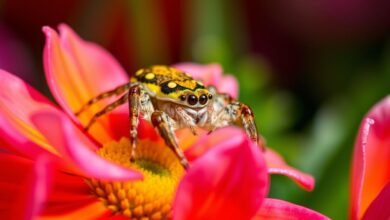Arácnido (Spider): Fascinating Arachnids
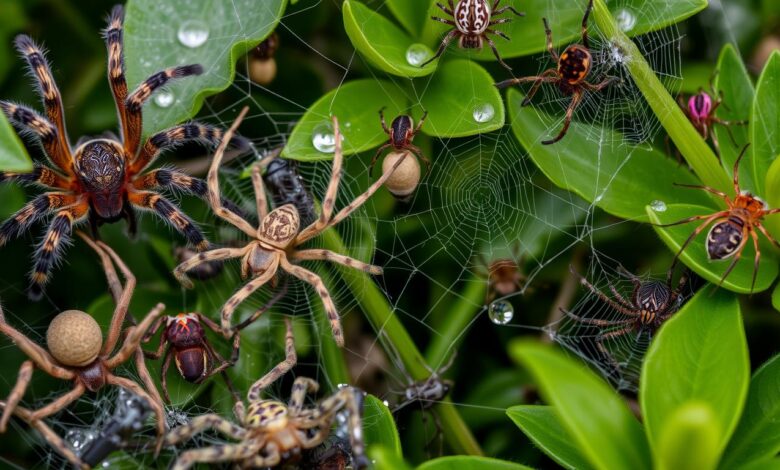
Get ready to explore the amazing world of arácnidos (spiders) and other arachnids. These creatures, part of the Chelicerata subphylum, are known for their unique traits. They spin webs and have venom, making them fascinating to many.
Arachnids vary greatly in size. Some are tiny, while others, like the scorpion Hadogenes troglodytes, can grow up to 21 cm long. They have two main parts: the cephalothorax and the abdomen. Each has six pairs of appendages, showing their diversity.
Let’s dive into the world of arachnids. You’ll learn about their special adaptations and how they help ecosystems. This journey will amaze you with their diversity and fascinating nature.
Introducing the Arachnid World
Arachnids are a fascinating group of arthropods in the subphylum Chelicerata. They have four pairs of legs and a body split into two parts: the cephalothorax and the abdomen. The arachnid world is full of diverse species, each with its own special traits and roles in nature.
What are Arachnids?
Arachnids include spiders, scorpions, mites, ticks, and daddy longlegs. These Arthropods have tough exoskeletons and jointed legs. Their bodies are divided into the cephalothorax and abdomen, each with unique features.
Diversity of Arachnid Species
The Arachnid class is incredibly diverse. They range from tiny mites to large scorpions. Arachnids come in all shapes and sizes, showing their ability to adapt and survive in different environments.
| Arachnid Subgroup | Characteristic Features |
|---|---|
| Spiders | Spinning intricate webs, using venomous fangs to immobilize prey |
| Scorpions | Possessing a venomous sting at the end of their tail, using pincers to capture and subdue prey |
| Mites and Ticks | Tiny in size, some are parasitic, feeding on the blood of their hosts |
| Daddy Longlegs | Characterized by their long, slender legs, often mistaken for spiders |

Spiders spin webs, while scorpions have venomous stings. Each Chelicerata subgroup has unique features and roles. This diversity makes the arachnid world truly captivating.
Arachnid characteristics
| Characteristic | Description |
|---|---|
| Exoskeleton | They have an outer skeleton that provides support and protection. |
| Eight Legs | Arachnids have four pairs of legs (eight in total), unlike insects, which have six legs. |
| Body Segments | Their body is divided into two main parts: the cephalothorax (fused head and thorax) and the abdomen. |
| Lack of Antennae | Unlike insects, arachnids do not have antennae. Instead, they have specialized appendages like pedipalps and chelicerae. |
| Simple Eyes | They generally have simple eyes instead of compound eyes; the number of eyes varies (spiders typically have six or eight eyes). |
| Respiratory System | They breathe through structures like book lungs or tracheae, adapted for terrestrial environments. |
| Carnivorous Diet | Most are carnivorous, feeding on small animals or insects, using venom or other methods to immobilize prey. |
| Silk Production | Many arachnids, especially spiders, produce silk to create webs, capture prey, or for shelter and reproductive purposes. |
| Venom | Some, like spiders and scorpions, have venomous bites or stings, used for capturing prey or self-defense. |
Anatomy and Physical Characteristics
Arachnids have a strong exoskeleton and a body divided into two parts. The cephalothorax (or prosoma) and the abdomen (or opisthosoma) make up their body. The cephalothorax has the chelicerae, pedipalps, and four pairs of legs. The abdomen has spinnerets for web-making in spiders.
Body Structure and Segmentation
Arachnids vary greatly in size. They can be as small as 0.08 mm mites or as large as 21 cm scorpions. Their bodies are split into two parts: the cephalothorax and the abdomen.
Appendages and Their Functions
Arachnids’ appendages help them catch prey, move, and sense their surroundings. The cephalothorax has six pairs of appendages. The chelicerae are for holding and crushing prey. The pedipalps act as touch organs or secondary sexual organs in spiders.
Some arachnids have special features. Scorpions have a short stinger with venom. Whip scorpions and micro whip scorpions have long, whip-like structures of unknown purpose.
| Appendage | Function |
|---|---|
| Chelicerae | Holding and crushing prey |
| Pedipalps | Touch organs or secondary sexual organs in spiders |
| Legs | Locomotion |
| Spinnerets (in spiders) | Web production |
| Stinger (in scorpions) | Delivering venom |
| Whip-like structures (in whip scorpions and micro whip scorpions) | Unknown function |
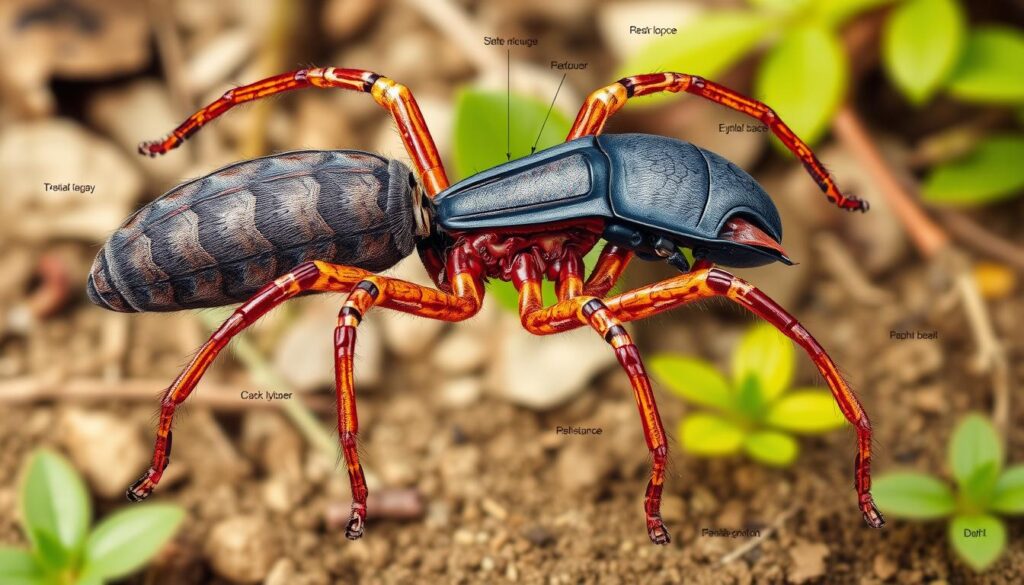
Arácnido (Spider): The Web-Spinning Marvel
Spiders, or arácnidos, are well-known and iconic. They are famous for spinning intricate webs to catch prey. Their silk is strong, elastic, and versatile.
Spiders have many web designs. Each one is made for their hunting style and where they live. They are important predators that help keep insect numbers in check and balance ecosystems.
In the Marvel Cinematic Universe, Spider-Man, played by Tom Holland, is back for Spider-Man 4. This starts a new trilogy for the web-slinging hero. Holland’s Spider-Man will have a bigger part in Avengers: Doomsday than before. Marvel and Sony are making him more part of the shared universe.
The new series Agatha, based on WandaVision, has started on Disney+. It’s adding more to the Marvel Cinematic Universe. It’s full of intrigue and spider-related themes.

The world of spider-related entertainment is growing. The fascination with these arachnid marvels is still strong. From movies to streaming, their web-spinning and captivating nature inspire fans everywhere.
Scorpions: The Venomous Predators
Scorpions are a unique group of arachnids known for their scary look and venomous sting. They use their long, segmented tail with a stinger to defend themselves and catch prey. The venom in their sting can be mild or very dangerous, depending on the scorpion type.
Defensive Mechanisms and Venom
Scorpions have a strong defense: their venomous sting. This stinger is at the end of their tail and is linked to a venom gland. The venom’s strength can vary a lot, with some scorpions being very dangerous to humans and others not being so bad.
Scorpions use their venom in different ways:
- Predation: They use venom to catch and stop their prey, like insects, other arachnids, and small animals.
- Defense: The venom also helps keep predators away, protecting the scorpion.
Even though some scorpions can be dangerous to humans, most are not. They are important in their ecosystems as both hunters and prey.

Mites and Ticks: The Tiny Arachnids
Mites and ticks are small, often microscopic arachnids in the subclass Acari. They live in many places, from soil to the bodies of animals. Some are harmless, but others can spread diseases to humans, animals, and wildlife, making them key disease vectors.
These arachnids are small and live close to their hosts. This helps them thrive and diversify. Mites and ticks range in size from tiny to quite large, showing the amazing variety of arachnids.
| Characteristic | Mites | Ticks |
|---|---|---|
| Size | Typically microscopic, ranging from 0.08 mm to a few millimeters | Larger than mites, ranging from a few millimeters to several centimeters |
| Habitat | Found in a variety of environments, including soil, plants, and animal hosts | Primarily found on the bodies of larger animals, including mammals, birds, and reptiles |
| Feeding | Feed on a variety of organic matter, including plants, animals, and fungi | Feed on the blood of their animal hosts |
| Disease Transmission | Can transmit various diseases, such as Lyme disease and Q-fever | Responsible for transmitting a wide range of diseases, including Lyme disease, Rocky Mountain spotted fever, and tick-borne encephalitis |
Mites and ticks are successful parasites and disease vectors because of their small size and adaptability. They pose health risks to humans and animals. Knowing how they work is key to fighting their impact.
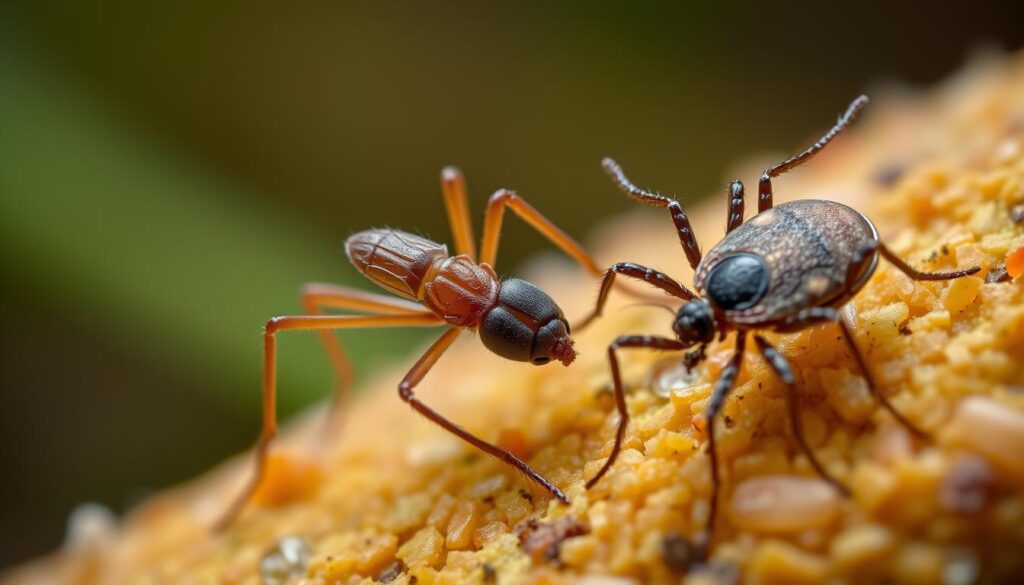
Daddy Longlegs: Myths and Realities
Daddy longlegs, also known as harvestmen or Opiliones, are fascinating arachnids often mistaken for spiders. The myth that they are the most venomous arachnids is not true. They do not have venom glands or fangs and are harmless to humans.
These arachnids have a unique look and behavior. They have a single, rounded body and long legs compared to their body size. They often gather in large numbers, making a striking sight in their habitats.
Daddy longlegs are key players in their ecosystems. They eat small creatures like insects and help break down decaying matter. This helps nutrients cycle in their environments.
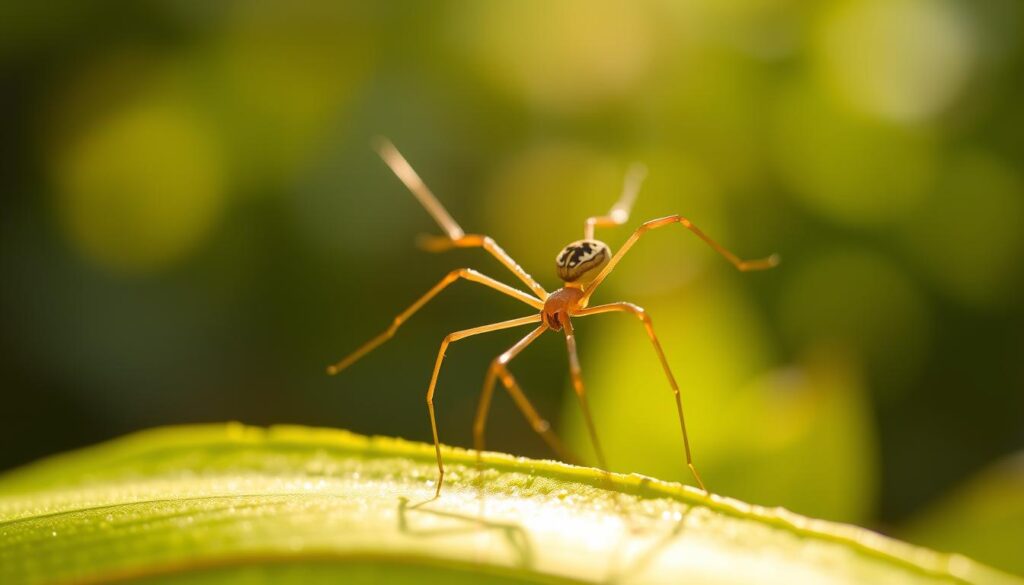
Despite myths about their venom, daddy longlegs are safe for humans. Their long legs and unique look might scare some, but they are not dangerous. They are interesting creatures that should be valued for their role in nature.
Arachnid Habitats and Distribution
Arachnids, including spiders, scorpions, mites, and ticks, live in many places around the world. They can be found in deserts, forests, and even cities. These creatures help make our planet’s ecosystems diverse and full of life.
Where Do Arachnids Live?
Arachnids live in a wide range of habitats. They can adapt to different environments. Here are some examples:
- Deserts and arid regions, where scorpions and certain spiders survive the dry conditions.
- Lush, dense forests, where web-spinning spiders build complex webs to catch prey.
- Urban environments, where some arachnids live alongside humans, even in our backyards.
- The depths of the ocean, where mites and ticks have adapted to life underwater.
Arachnids are found on every continent except Antarctica. Their wide distribution shows how important they are for keeping ecosystems balanced.
| Arachnid Species | Habitat | Geographic Distribution |
|---|---|---|
| Stenolpium sayrii sp. nov. | Coastal Peruvian Desert | Lima city, Peru, at an elevation of 105 meters |
| Hadogenes troglodytes | Africa | Can reach lengths of 21 cm (8 inches) or more |
| Tiny mites | Diverse habitats | As small as 0.08 mm (0.003 inches) |
Knowing where arachnids live and how they spread out is key for saving them. Their ability to adapt and their wide distribution make them crucial for our planet’s biodiversity.
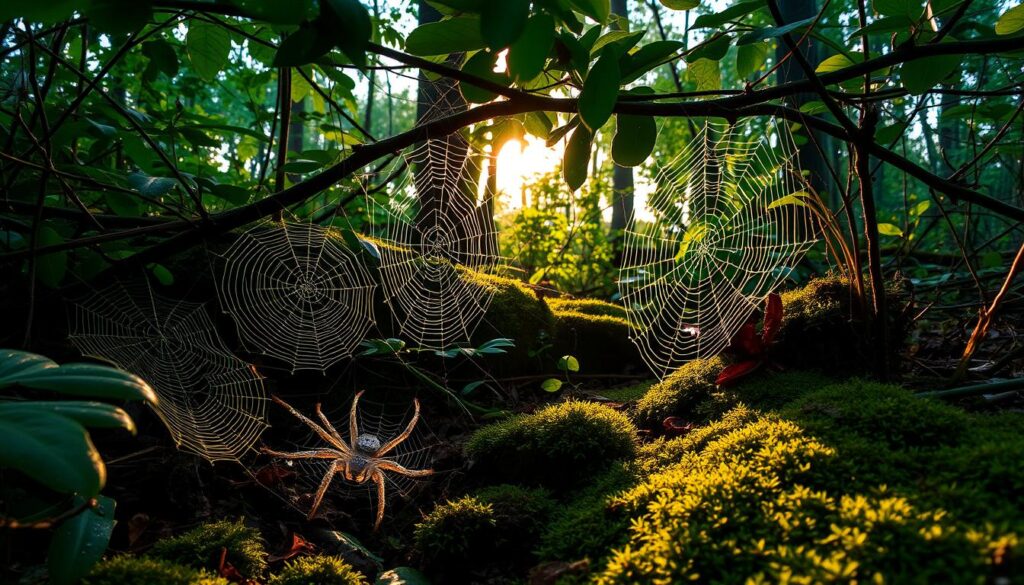
Predatory Behavior and Feeding Habits
Arachnids are amazing predators with many hunting strategies. Spiders spin webs to catch insects and small animals. Scorpions use their venom and strong pincers to take down prey.
Mites and ticks feed on the blood or fluids of larger animals. Knowing how arachnids hunt and eat helps us understand their role in nature.
- Arachnids range in size from tiny mites measuring 0.08 mm (0.003 inch) to the large scorpion Hadogenes troglodytes of Africa, which can exceed 21 cm (8 inches) in length.
- Arachnids lack jaws, and most species are predatory, injecting digestive fluids into their prey before consuming its liquefied remains.
- The arachnid body is divided into two main regions: the cephalothorax (prosoma) and the abdomen (opisthosoma), except in some species like daddy longlegs and mites where the body is a single region.
Arachnids have different ways to catch their prey. Spiders use webs, while scorpions rely on venom and pincers. Mites and ticks feed on the blood of larger animals.
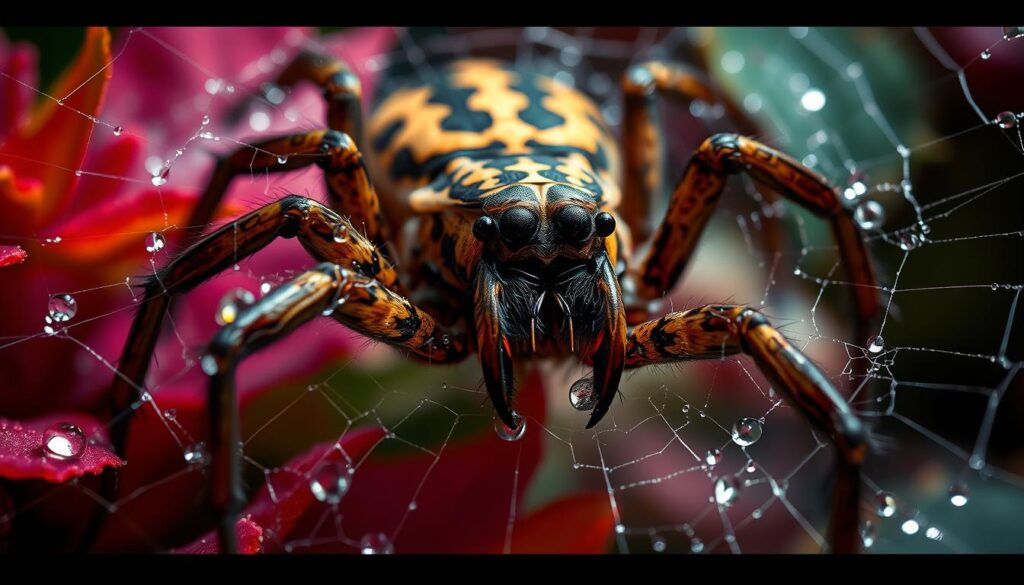
The variety in arachnid hunting and eating shows their importance in nature. By studying these behaviors, we learn more about the world around us.
Reproduction and Life Cycles
Arachnids, including spiders, scorpions, and mites, have unique ways of reproducing and growing. Many, like spiders and scorpions, lay eggs that hatch into tiny versions of adults. These young ones look like the parents but are smaller and might have different features.
Some arachnids, like mites and ticks, have more complex life cycles. They go through metamorphosis, changing from larvae to nymphs and then to adults. Each stage has its own look and behavior.
The way arachnids reproduce and grow can change based on their environment. Things like temperature, humidity, and food availability can affect their reproductive success. These factors also impact the survival and growth of their offspring.

Learning about the different life cycles and reproductive methods of arachnids helps us understand them better. By looking into their reproduction and development, we see how they adapt and survive in various places.
Arachnid Silk: Properties and Uses
Spider Silk: A Remarkable Material
Spiders are known for making strong, elastic silk. Spider silk is amazing because it’s both strong and flexible. Scientists are excited to use it in fields like medicine, textiles, and green materials. Its unique qualities keep leading to new discoveries and ideas.
Spider silk is incredibly strong, even stronger than steel in some cases. Yet, it’s also very elastic, like nylon. This makes it perfect for many uses. It’s being looked at for making bulletproof vests, artificial body parts, and even biodegradable stitches.
Spider silk is also safe for the body, which makes it great for medical uses. It could help grow new tissue and heal wounds. Scientists are working on using it to help cells grow and for drug delivery systems.
Spider silk isn’t just for medicine. It’s also being used in making high-quality fabrics. This is a big step towards creating sustainable, eco-friendly clothing.
As we learn more about arachnid silk, its uses are growing. It could help protect us and heal our bodies. The possibilities are endless and very exciting for the future.

| Properties of Spider Silk | Comparative Materials |
|---|---|
| Tensile Strength |
|
| Elasticity |
|
| Biocompatibility |
|
| Sustainability |
|
Arachnids in Myths and Folklore
Arachnids, like spiders and scorpions, have been part of myths, legends, and cultural beliefs globally. They are often seen as symbols of fear, danger, and even supernatural powers in folklore. These stories show how much humans are drawn to these creatures and how they’ve become a part of our culture and stories.
In many mythologies, spiders are seen as clever, web-weaving deities or tricksters. For example, the Anansi from West African folklore is famous for his cunning and cleverness. In Native American cultural beliefs, the Spider Woman is a creator goddess who taught people how to weave and spin.
Scorpions are often connected to vengeance, protection, and even rebirth in mythological and folkloric stories. In ancient Egypt, the goddess Serket was linked to scorpions and was believed to protect against their venom.
These arachnid-centric myths and cultural beliefs still fascinate us today. They show the lasting interest these amazing creatures have in our imagination.
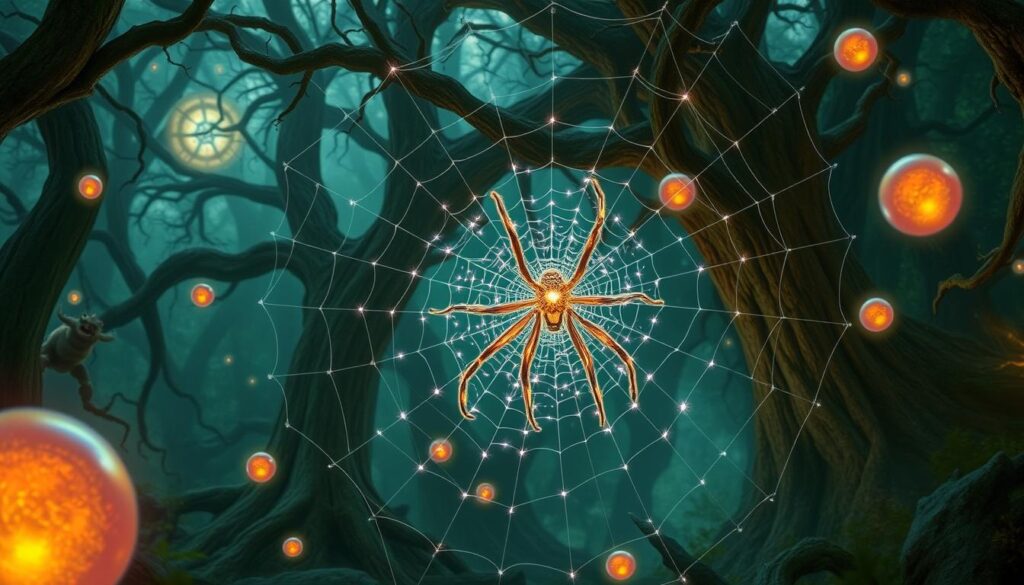
Conservation Efforts and Threats
Arachnids are vital to the balance of ecosystems worldwide. Yet, they face many threats. These include habitat loss, invasive species, and the effects of climate change. They must adapt to a changing world to survive.
Protecting Arachnid Biodiversity
It’s essential to protect arachnid species and their habitats. Conservation efforts include restoring habitats and educating the public. This helps keep these creatures in our ecosystems.
Protecting arachnids helps maintain ecosystem balance. Each species, from the Goliath Birdeater to the New Zealand Katipo, is crucial. They all contribute to the web of life on Earth.
| Threat | Impact | Conservation Efforts |
|---|---|---|
| Habitat Loss | Destruction and fragmentation of natural habitats can lead to a decline in arachnid populations. | Habitat restoration, conservation of protected areas, and sustainable land-use practices. |
| Invasive Species | The introduction of non-native arachnids and other species can disrupt the delicate balance of ecosystems, outcompeting native species. | Regulation of invasive species, eradication programs, and public awareness campaigns. |
| Climate Change | Shifts in temperature, precipitation, and other environmental factors can impact the survival and reproduction of arachnid species. | Mitigation and adaptation strategies to address the effects of climate change, such as habitat conservation and restoration. |

By joining forces, we can help arachnids thrive for future generations. It’s a challenge we must face together.
Fascinating Arachnid Facts
Arachnids are full of interesting facts that amaze both scientists and the public. They can spin webs like spiders or defend themselves with venom like scorpions. These creatures have evolved amazing adaptations and behaviors over millions of years.
Did you know arachnids come in all sizes? From tiny mites at 0.08 mm to the huge African scorpion, Hadogenes troglodytes, which can grow up to 21 cm (8 inches)? Their size range shows how adaptable and resilient they are.
Arachnids have a unique body shape. Their body is split into the cephalothorax (prosoma) and the abdomen (opisthosoma), except for some like daddy longlegs and mites. They don’t have jaws and instead, they inject digestive fluids into their prey before eating it.
| Arachnid Fact | Details |
|---|---|
| Body Structure | The cephalothorax is covered by a carapace and bears six pairs of appendages, including chelicerae, pedipalps, and walking legs. The abdomen can have up to 13 somites in scorpions, and some species even have a postabdomen. |
| Venomous Defenses | Scorpions possess a short stinger with a swollen base housing a poison gland, while whip scorpions and micro whip scorpions have distinct anatomical features for unknown purposes. |
| Arachnid Adaptations | Arachnids have evolved a remarkable array of adaptations and behaviors, including the web-spinning abilities of spiders and the venomous defenses of scorpions. |
These Arachnid Facts and Interesting Information highlight the amazing diversity and complexity of arachnids. As we learn more about these creatures, we’ll discover even more Arachnid Trivia. This will help us appreciate these remarkable arthropods even more.

Research and Future Discoveries
The study of arachnids is always growing, with new findings and insights popping up all the time. Advances in fields like molecular biology and advanced imaging are helping researchers learn more about arachnid biology. They’re also exploring how arachnids interact with their surroundings.
As scientists learn more about arachnids, they’re venturing into new areas. They’re studying spider silk and looking into how arachnids can help in fields like medicine and sustainable materials. This journey of Scientific Advancements is full of possibilities for future discoveries.
The future looks bright, with researchers using Emerging Technologies to learn even more about arachnids. They’re figuring out how spiders communicate and exploring the uses of arachnid venom. As you delve deeper into the world of arachnids, get ready to be amazed by the scientific wonders that await.



